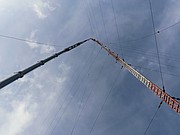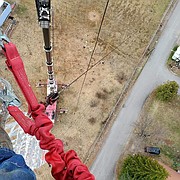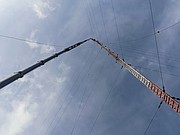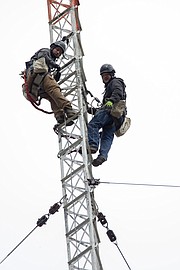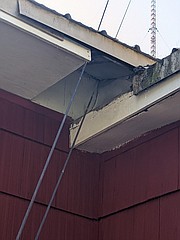KWAL radio tower comes down
OSBURN — Video seems to have truly killed the radio star.
A small crowd could be seen gathered around the old KWAL-AM 620 radio station in Osburn Thursday morning to not only watch the spectacle of work crews disassembling a 310-foot tall tower, but also pay their respects to a once great source of local entertainment.
When KWAL went dark on Sept. 5, 2018, it was the third oldest radio station in the state and had been a hub for mobile information over the years. Its host provided local listeners access to music, election results, school lunch menus, school closures, regional and national news, and local sports play-by-play.
Just over a month ago, Osburn Mayor Kip McGillivary and Cozmo Construction owner John Schroeder acquired the property and decided to clear out the old station/tower in order to make room for more housing.
"John Schroeder and I partnered on this to bring some more buildable land to the city of Osburn and were focused on fulfilling our dream," McGillivary said.
To get the delicate job of bringing down the 74-year-old tower done, the duo brought in Kasco of Idaho.
Kasco owner Keith Sims explains that workers arrived at the site around 7 a.m. Thursday following numerous survey visits previously.
"We had made probably half a dozen trips out there to try to get counter weights and guy wire weights, and document as much information as we could so we could plan for success," he said.
After ruling out the simple fall-it-like-a-tree method due to safety concerns, the crews utilized a giant crane and two workers to climb the tower and disassemble it section by section.
The radio tower, constructed in 1947, had 21 total guy wires attached to it for support. Each one was roughly 450 feet in length and several of which were grounded in peculiar places.
"The guy wires on the northwest side were in two people's backyards…and one set went through a guy's roof," Sims said.
Ben Bakken and Sam Sheppard, two longtime Kasco employees, were the lucky duo that got to climb up the tower and saw away at the old steel. Initially the plan was to release the bolts connecting the tower together, but years of rust made that method less convenient.
Sims explained that they brought the tower down in four sections, the first three being roughly 40 feet in length. Cuts would be made, then the crane would do the rest and haul of the severed pieces.
The first top section was the hardest, but the going got easier from there.
"Once that first section hit the ground, we learned a lot about what we needed to do," Sims said.
By 12:45 p.m., the last section had hit the ground with no injuries or damage reported.
Moving forward, the steel from the tower will be recycled by McGillivray Environmental and the actual station building will be targeted next for demolition in the coming weeks.
"We're very excited to begin the process of getting the land subdivided and preparing lots for future homes," McGillivary said.
KWAL in its final form came to be after Paul Robinson and other investors bought the station from Lee Black in the fall of 1971 and reopened the station in 1972. In 1977, Robinson hired his right-hand man, George White, and the two rode the waves together until 2018.
Over the years, the station experienced the financial hardships that have been felt by nearly every smaller media outlet across the country, but KWAL powered on longer than most.
Besides lost revenue to the internet, KWAL suffered a death blow when the Federal Communications Commission (FCC) declined to renew the station’s extension to utilize their single radio tower at 250 watts and would only allow them to operate at 60 watts. What that means is they would only be able to power a signal as far as Silverton.
There was a second radio tower at one time, but in 2016 the tower was destroyed after an inattentive driver clipped the guy wire, pulling the tower down into the South Fork Coeur d’Alene River. That second tower allowed KWAL to operate at night on a lower strength signal, so as to keep the signals from crossing with ones in Spokane, Western Montana, and even as far away as Portland, Ore.
After the tower was destroyed, the FCC allowed the station to use the remaining tower to broadcast at 250 watts, which kept the signal strong enough to broadcast from Kingston to Mullan.
Unfortunately, the driver who pulled the tower down also hit some power poles that caused the power to go out in the Sunny Slopes area and after the power company got their cut of the insurance money, there wasn’t enough left for KWAL to pay the near-$200,000 it would have taken to get a new tower and then have it set up and calibrated.






